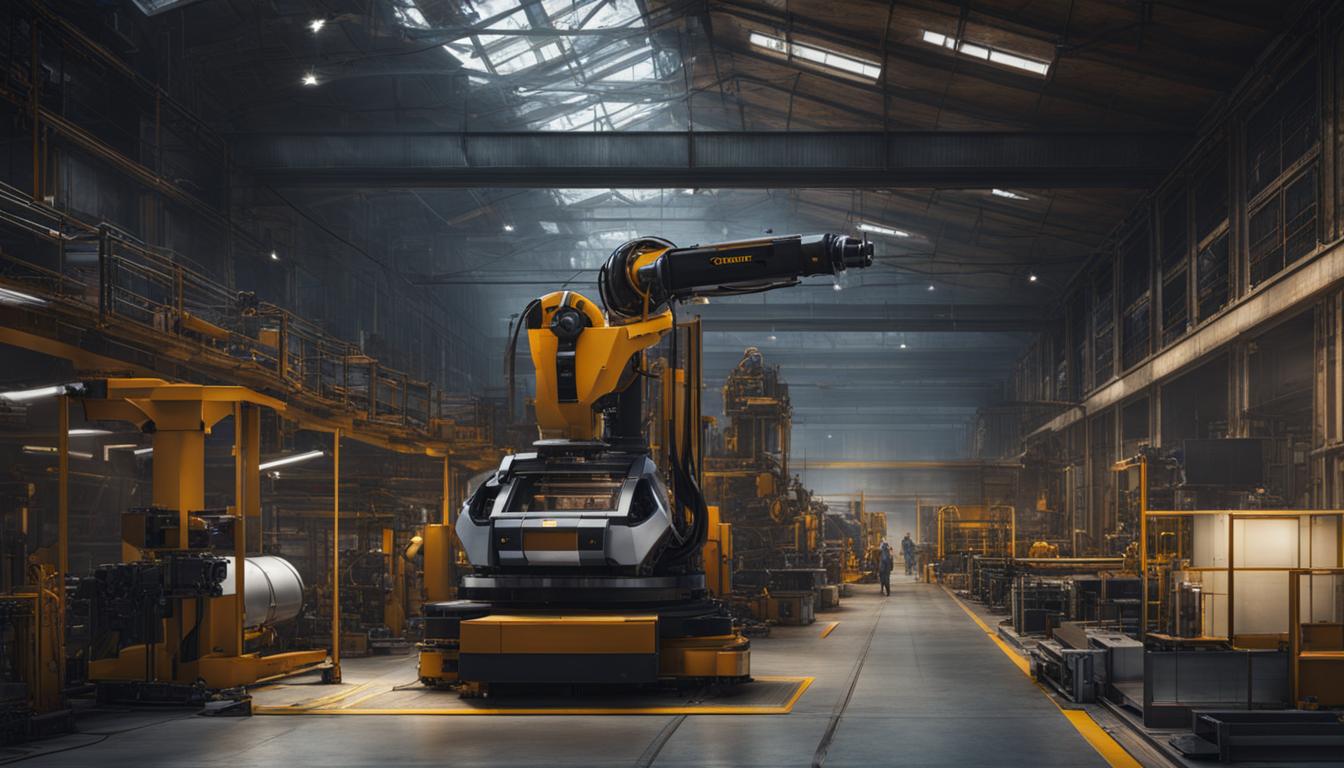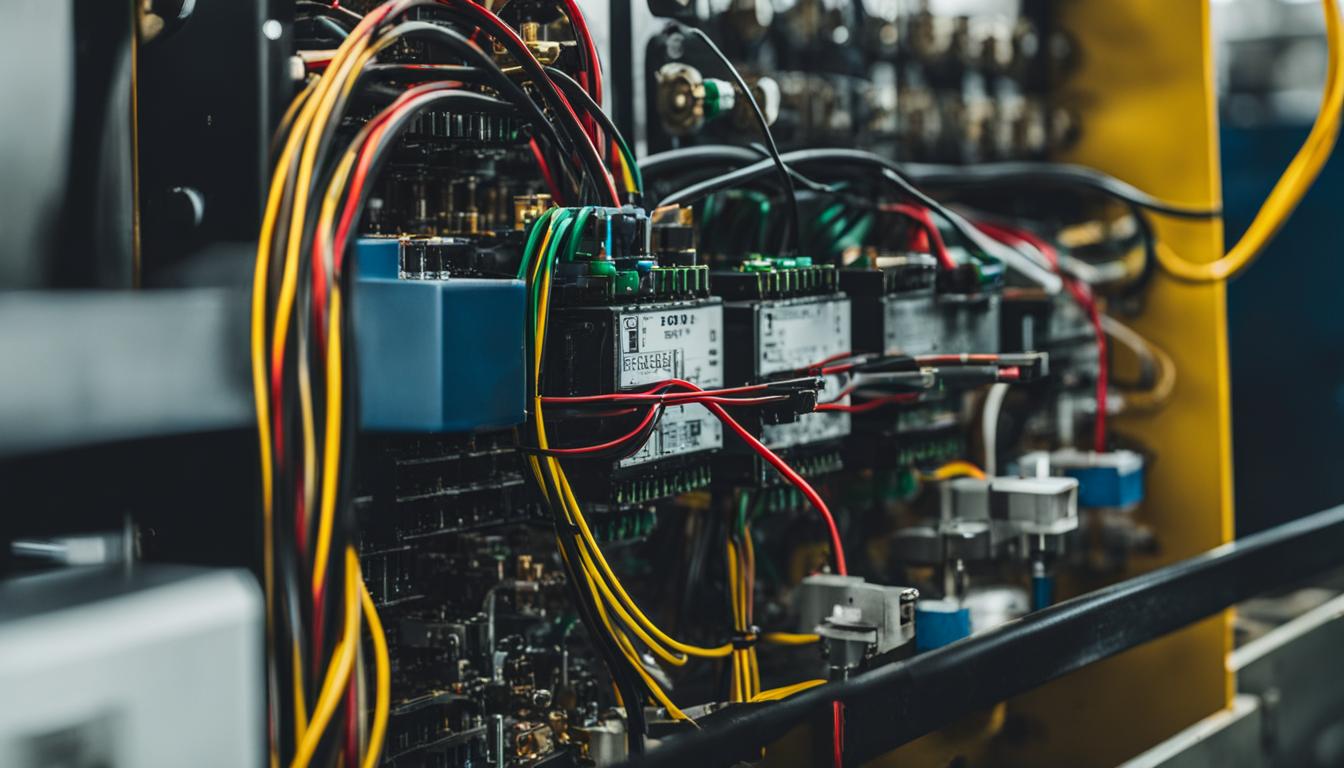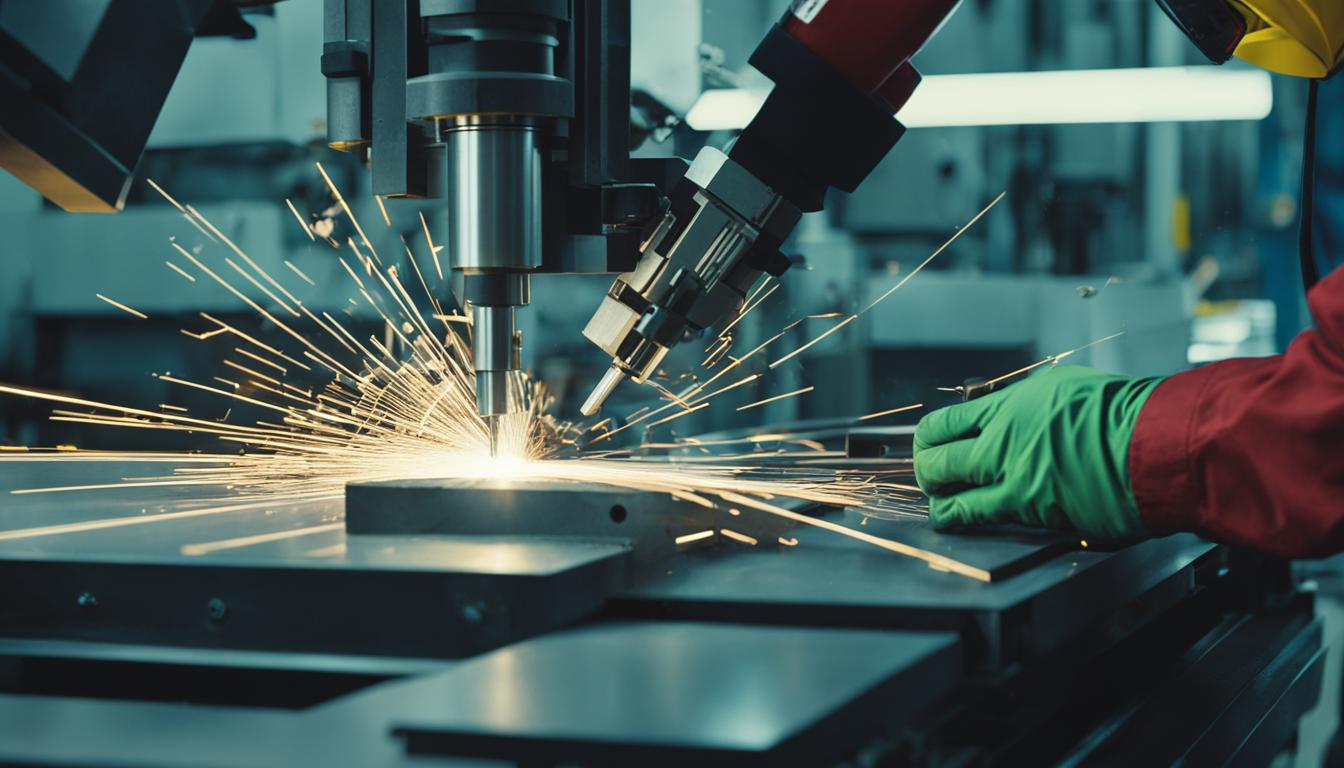The emergence of Industry 4.0 has revolutionized the manufacturing industry, aiming to create a smart factory with interconnected, digitized, and automated processes. Robotics has become a crucial technology in achieving the objectives of Industry 4.0. By integrating robots into manufacturing processes, businesses can increase productivity, reduce costs, improve product quality, and meet customer demands more efficiently.
However, implementing robotics comes with challenges such as high costs and the need for specialized skills. Nevertheless, the benefits of using robots in Industry 4.0 far outweigh the challenges, leading to a more efficient, cost-effective, and sustainable manufacturing industry.
Key Takeaways:
- Industry 4.0 brings interconnected, digitized, and automated processes to the manufacturing industry.
- Robotics is a crucial technology in achieving the objectives of Industry 4.0.
- Integrating robots in manufacturing processes increases productivity and reduces costs.
- Robots improve product quality and enable businesses to meet customer demands more efficiently.
- The benefits of using robots in Industry 4.0 outweigh the challenges, leading to an efficient and sustainable industry.
The Evolution of Robotics in Manufacturing
The use of robotics in manufacturing has significantly evolved over the years, driven by advancements in Industry 4.0. As businesses strive to optimize their operations and gain a competitive edge, robotics has emerged as a key technology that offers numerous advantages for companies in the manufacturing industry.
In the 1950s and 1960s, the first industrial robots were developed, primarily for tasks such as spot welding. These early robots laid the foundation for automation in manufacturing and paved the way for further advancements.
During the 1970s and 1980s, the introduction of microprocessors revolutionized the robotics industry. The use of microprocessors enabled robots to have more precise control over their movements and perform complex tasks with greater accuracy. This development expanded the capabilities of robots and their potential applications in manufacturing.
In the 1990s and 2000s, vision systems and collaborative robots emerged as significant innovations in robotics. Vision systems allowed robots to perceive their environment and make informed decisions based on visual inputs. Collaborative robots, also known as cobots, were designed to work alongside human operators, enhancing productivity and safety in manufacturing processes.
Today, with the integration of robotics in Industry 4.0, we have witnessed the rise of mobile robots capable of navigating complex environments and working collaboratively in teams. These robots can autonomously move around the factory floor or warehouse, performing tasks such as material handling and transportation. The evolution of robotics has transformed the manufacturing industry, enabling businesses to achieve new levels of efficiency, productivity, and quality.
Advancements in Industry 4.0 have further enhanced the benefits of robotics in manufacturing. Companies can leverage robotics to increase productivity, improve product quality, and reduce costs. By automating repetitive and mundane tasks, robots free up human employees to focus on higher-value activities, leading to increased overall productivity.
Moreover, robots can perform tasks with a high degree of precision, minimizing errors and defects in the manufacturing process. This results in improved product quality, leading to higher customer satisfaction and reduced waste in production.
The implementation of robotics in manufacturing also offers significant cost benefits. While the initial investment in robotic systems may be substantial, the long-term cost savings are considerable. Robots can work continuously without breaks or fatigue, reducing the need for human labor and minimizing production downtime. Additionally, robots can operate in hazardous environments, eliminating the risk of workplace accidents and associated costs.
Furthermore, robots in Industry 4.0 are designed to be flexible and adaptable. They can easily be reprogrammed or reconfigured to perform different tasks or accommodate changes in production requirements. This flexibility enables manufacturers to quickly respond to market demands and optimize their production processes.
In addition, robots integrated into Industry 4.0 systems facilitate data collection and analysis. Through sensors and connectivity, robots gather valuable production data, enabling real-time monitoring, analysis, and optimization of manufacturing processes. This data-driven approach empowers businesses to make informed decisions, identify areas for improvement, and implement continuous enhancements.
The use of robotics in manufacturing not only enhances operational efficiency but also improves working conditions for employees. By automating physically demanding or hazardous tasks, robots help reduce the risk of work-related injuries and create a safer working environment. This fosters a positive workplace culture and promotes employee well-being.
In conclusion, the evolution of robotics in manufacturing, propelled by advancements in Industry 4.0, has revolutionized the industry. The integration of robotics offers businesses numerous advantages, including increased productivity, improved product quality, reduced costs, enhanced safety, flexibility, data collection, and improved working conditions. As manufacturers embrace the opportunities and benefits of robotics, they position themselves for success in the highly competitive manufacturing landscape.
Types of Robots in Manufacturing
In manufacturing, robots play a crucial role in driving the advancements and benefits of Industry 4.0. Different types of robots are used, each offering unique features and capabilities to enhance various manufacturing processes.
Industrial Robots
Industrial robots are the most commonly used type of robots in manufacturing. These robots are designed to perform tasks such as welding, painting, and assembly with precision and speed. By automating these processes, industrial robots contribute to increased productivity, improved product quality, and reduced labor costs.
Collaborative Robots
Collaborative robots, also known as cobots, are designed to work alongside human operators. These robots excel in tasks that require human-robot interaction, such as intricate assembly or small-scale production. By collaborating with humans, cobots enhance efficiency, flexibility, and safety in the manufacturing industry.
Mobile Robots
Mobile robots are designed to navigate and operate in dynamic environments, such as factory floors or warehouses. These robots are equipped with autonomous navigation systems that enable them to transport materials, goods, or equipment efficiently. Mobile robots contribute to the optimization of material handling and transportation processes, resulting in improved operational efficiency.
By utilizing various types of robots in manufacturing, businesses can achieve significant benefits and advantages in the Industry 4.0 era. Industrial robots enhance productivity and quality, collaborative robots improve human-robot collaboration, and mobile robots optimize material handling and transportation processes.

With the utilization of advanced robotics technologies, the manufacturing industry can harness the power of Industry 4.0 to achieve greater efficiency, cost-effectiveness, and competitiveness.
The Role of Robotics in Achieving Industry 4.0 Objectives
Robotics plays a crucial role in achieving the objectives of Industry 4.0. By leveraging the advancements in Industry 4.0 technologies, businesses can reap a multitude of benefits. One of the key advantages of implementing Industry 4.0 is the increased productivity brought about by automation. Robots are capable of handling complex and repetitive tasks, operating continuously without the need for rest or downtime. This leads to faster production rates and reduced cycle times, resulting in a more efficient manufacturing process.
Another significant benefit of integrating robotics in Industry 4.0 is the improvement in product quality. Humans are prone to errors, but robots can perform tasks with precision, ensuring consistency and reducing the risk of defects. This results in higher-quality products that meet customer expectations and enhance brand reputation.
In addition to productivity and quality improvements, robotics in Industry 4.0 brings about cost savings. Labor costs constitute a significant portion of manufacturing expenses, and replacing human workers with robots can significantly lower these costs. Moreover, robots minimize instances of scrap and rework due to their accuracy, leading to further cost reductions.
Furthermore, the implementation of robots in hazardous environments improves workplace safety. By replacing humans in dangerous tasks, the risk of accidents and injuries is significantly reduced. This ensures a safer working environment, protecting the well-being of employees and reducing liability for businesses.
Flexibility is another advantage of robotics in Industry 4.0. Robots can be easily programmed and reconfigured to adapt to changing production requirements. This flexibility allows businesses to quickly respond to market demands, produce customized products, and stay competitive in the industry.
Data collection is a crucial aspect of Industry 4.0, and robotics enables the collection of valuable data for informed decision-making. Through sensors and monitoring systems, robots can gather real-time data on performance, efficiency, and maintenance needs. This data can then be analyzed to identify areas for improvement, optimize processes, and drive continuous innovation.
Lastly, robotics in Industry 4.0 improves working conditions for employees. By automating mundane and physically demanding tasks, robots relieve workers from repetitive and strenuous labor. This frees up their time and energy, allowing them to focus on higher-value tasks that require their creativity and problem-solving skills.
The benefits of implementing Industry 4.0 and leveraging robotics extend beyond manufacturing. The impact of Industry 4.0 technologies reaches various sectors, making businesses more agile, efficient, and competitive in today’s fast-paced digital era.

| Benefits of Implementing Industry 4.0 | Impact of Industry 4.0 | Industry 4.0 Advantages for Businesses |
|---|---|---|
| Increased productivity through automation | Improved product quality and consistency | Cost savings through reduced labor expenses |
| Enhanced workplace safety by replacing humans in hazardous environments | Flexibility to adapt to changing market demands | Data collection for informed decision-making |
| Improved working conditions by relieving employees from repetitive tasks |
Implications of Industry 4.0 Robotics in the Workplace
The adoption of robotics and other Industry 4.0 technologies in the workplace has profound implications for businesses in the manufacturing industry. These advancements bring a multitude of benefits and open up new opportunities for growth and success.
One of the key advantages of integrating Industry 4.0 robotics is the significant increase in labor productivity. With robots performing repetitive and mundane tasks, human workers can focus on more complex and value-added activities. This not only boosts overall productivity but also enables businesses to achieve higher production output with the same or fewer resources.
Additionally, the use of robotics reduces overhead costs. Automating processes can lead to substantial cost savings by minimizing the need for manual labor and lowering overall operational expenses. Moreover, robots can work continuously without breaks or downtime, allowing for round-the-clock production and maximizing output.
The integration of robotics also lowers the risk of human error. By replacing manual tasks with automated processes, businesses can improve the accuracy and precision of their operations. This not only enhances product quality but also reduces the possibility of errors that can result in waste, rework, or customer dissatisfaction.
Furthermore, the introduction of Industry 4.0 robotics improves efficiency within the workplace. By streamlining processes and eliminating bottlenecks, businesses can achieve smoother and more streamlined operations, resulting in increased efficiency and faster turnaround times.
The advantages of Industry 4.0 robotics extend beyond productivity and cost savings. Implementing robotics in the workplace also has a positive impact on safety. With robots taking over hazardous or physically demanding tasks, the risk of injuries to human workers is significantly reduced. This promotes a safer working environment and protects employees from potential harm.
The flexibility of robotics is another significant implication. With rapid advancements in technology, robots can be easily reprogrammed or reconfigured to adapt to changing market demands. This agility allows businesses to quickly adjust their production processes, cater to customized product requests, and stay ahead of the competition.
In conclusion, the integration of Industry 4.0 robotics in the workplace offers numerous benefits for businesses in the manufacturing industry. From increased labor productivity and reduced costs to improved safety and flexibility, the implications are wide-ranging and far-reaching. Embracing robotics as part of the Industry 4.0 revolution provides businesses with a competitive edge, driving productivity, profitability, and overall success.
Conclusion
In conclusion, Industry 4.0 has brought about significant benefits and advantages to the manufacturing industry through the use of robotics. By implementing Industry 4.0 technologies, businesses can experience increased productivity, improved product quality, and reduced costs. The integration of robotics enables automated and efficient processes, leading to faster production rates and better overall performance.
Additionally, the impact of Industry 4.0 robotics extends to safety and working conditions. By replacing humans in hazardous environments, robotics enhances safety and reduces the risk of injuries. Moreover, the flexibility of robotics allows for quick adaptation to market demands, ensuring businesses can meet customer requirements and produce customized products.
Overall, the benefits of implementing Industry 4.0 technologies and incorporating robotics in manufacturing far outweigh the challenges. By embracing this transformative approach, businesses can achieve higher levels of efficiency, cost-effectiveness, and sustainability. The future of manufacturing lies in the seamless integration of robotics and other Industry 4.0 technologies, paving the way for a more advanced and competitive industry.
FAQ
What are the benefits of using robotics in Industry 4.0?
The benefits of using robotics in Industry 4.0 include increased productivity, improved product quality, reduced costs, enhanced safety, flexibility, data collection for informed decision-making, and improved working conditions.
How has robotics evolved in the manufacturing industry?
Robotics in the manufacturing industry has evolved from the development of industrial robots in the 1950s-1960s to the introduction of microprocessors in the 1970s-1980s, vision systems and collaborative robots in the 1990s-2000s, and now mobile robots capable of navigating complex environments and working in teams.
What types of robots are used in manufacturing?
Different types of robots used in manufacturing include industrial robots for welding, painting, and assembly; collaborative robots designed to work alongside human operators; and mobile robots for material handling and transportation.
What is the role of robotics in achieving Industry 4.0 objectives?
Robotics plays a crucial role in achieving Industry 4.0 objectives by increasing productivity, improving product quality, reducing costs, enhancing safety, providing flexibility, enabling data collection for informed decision-making, and improving working conditions.
What are the implications of using robotics in Industry 4.0 in the workplace?
The implications of using robotics in Industry 4.0 in the workplace include increased labor productivity, reduced overhead costs, lower human error, improved efficiency, 24/7 task completion, better safety, quick adaptation to market demands, and production of customized products.




